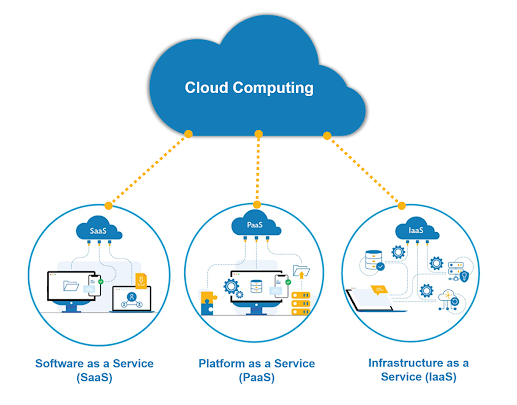How Cloud Computing works?
Cloud computing is a model for delivering computing resources over the internet. In this model, users can access computing resources, such as servers, storage, databases, and software applications, on a pay-per-use basis, without having to invest in and maintain their own computing infrastructure.
The basic steps of how cloud computing works.
Users access the cloud: Users access cloud computing
resources through the internet using a web browser, mobile app, or other client application.
Resource allocation: When a user requests computing
resources, the cloud service provider allocates those resources from its pool
of available resources. This can include virtual machines, storage, and network
resources.
Resource deployment: Once the resources are
allocated, the cloud service provider deploys them and configures them
according to the user's needs.
User access: The user can now access and use the
allocated resources via the internet.
Resource scaling: Cloud computing allows for easy
scaling of resources, which means that users can easily increase or decrease
the amount of computing resources they need as their requirements change. This
can be done automatically, through the use of auto-scaling algorithms, or
manually, by the user or administrator.
Resource management: The cloud service provider is
responsible for managing the computing resources, including maintenance,
upgrades, and security.
Cloud computing provides users with an easy and cost-effective way to access computing resources, without having to invest in and maintain their own infrastructure.
Cloud computing can be used in many different areas, including:
Infrastructure as a Service (IaaS): IaaS provides virtualized
computing resources, such as servers, storage, and networking, over the
internet. This allows organizations to easily scale their infrastructure up or
down as needed, without having to invest in their own physical hardware.
Platform as a Service (PaaS): PaaS provides a platform for
developers to build, test, and deploy their applications. This allows
developers to focus on writing code, without having to worry about the
underlying infrastructure.
Software as a Service (SaaS): SaaS provides access to
software applications over the internet, without requiring users to install or
maintain the software themselves. This can include applications for email,
document management, and customer relationship management.
Big data and analytics: Cloud computing can be used to
store and process large amounts of data, as well as to perform complex
analytics on that data. This can be useful for businesses looking to gain
insights into customer behavior, market trends, and more.
Internet of Things (IoT): Cloud computing can be used to
store and process data from IoT devices, such as sensors and cameras. This can
allow organizations to gain insights into the performance of their devices, as
well as to develop new applications and services based on that data.
Features of Cloud Computing
Cloud
computing has several key features that make it a popular choice for
organizations of all sizes. Here are some of the most important features of
cloud computing:
On-demand self-service: Cloud computing allows users to
access computing resources on a self-service basis, without having to go through
an IT department or service provider. This means that users can easily
provision and configure resources as needed, without having to wait for
approval or assistance.
Broad network access: Cloud computing resources are
accessible over the internet, which means that users can access them from
anywhere, using any device with an internet connection.
Resource pooling: Cloud computing resources are
pooled together, which means that users can access a shared pool of resources,
rather than having to rely on dedicated resources. This allows for more
efficient resource utilization and can reduce costs.
Rapid elasticity: Cloud computing resources can
be scaled up or down rapidly, depending on the needs of the user. This allows
users to easily adjust their resource usage to match changing demand, without
having to invest in additional infrastructure.
Measured service: Cloud computing providers
typically charge users based on the amount of resources they use, which means
that users only pay for what they need. This allows for more efficient resource
usage and can reduce costs.
There
are several companies that are widely considered to provide some of the best
cloud computing services in the world. Some of them are mentioned below.
List of Top Cloud Computing Service Providers
Amazon Web Services (AWS)
AWS is a subsidiary of Amazon that provides a wide range of cloud computing services, including IaaS, PaaS, and SaaS. AWS is one of the most popular cloud providers in the world, with a market share of around 33%.Microsoft Azure
 Azure is a cloud computing
platform offered by Microsoft that provides IaaS, PaaS, and SaaS services.
Azure is one of the fastest-growing cloud providers, with a market share of
around 20%.
Azure is a cloud computing
platform offered by Microsoft that provides IaaS, PaaS, and SaaS services.
Azure is one of the fastest-growing cloud providers, with a market share of
around 20%.
Google Cloud Platform (GCP)
GCP is a suite of cloud computing services offered by Google, including IaaS, PaaS, and SaaS. GCP is known for its strong focus on artificial intelligence and machine learning.
IBM Cloud
IBM Cloud is a cloud computing platform offered by IBM that provides IaaS, PaaS, and SaaS services. IBM Cloud is known for its strong focus on enterprise customers.
Oracle Cloud
Oracle Cloud is a cloud computing platform offered by Oracle that provides IaaS, PaaS, and SaaS services. Oracle Cloud is known for its strong focus on database services and enterprise applications.



Comments
Post a Comment